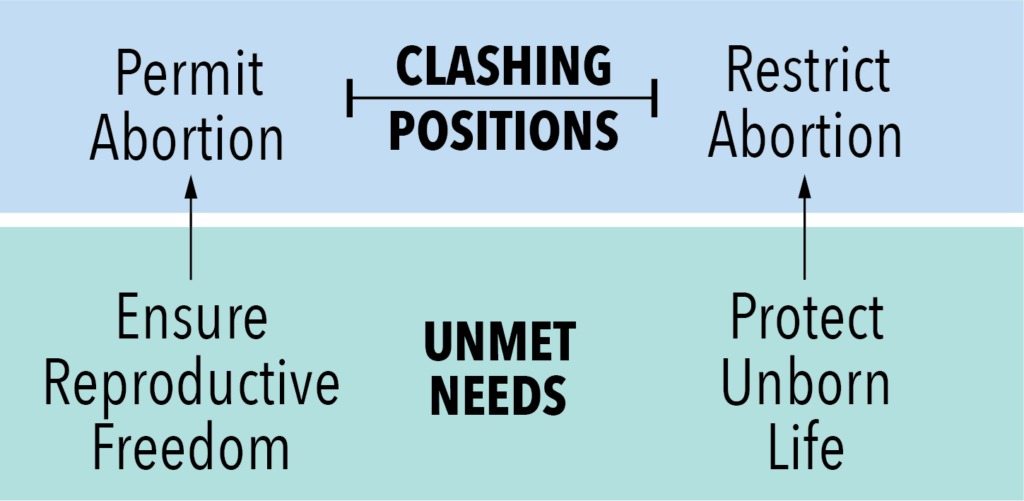Michael F. Mascolo, Ph.D.
As discussed in How to Have a Political Conversation About Abortion I: Lead with Compassion, before trying to engage in a political conversation, it is helpful to try to establish a connection with your partner. Even if you disagree with your partner’s political positions on a topic, it is essential to honor their dignity and humanity. It is important to approach your partner with respect, compassion and empathy. One way to do this is to invite your partner to share, in an empathic and nonjudgmental context, his or her story about how they came to adopt the political position that they do.
The opportunity to hear and be heard with empathy and compassion goes a long way toward establishing conditions favorable for a problem-solving discussion. When partners are treated with dignity and compassion, they are more able to approach a conflict with a mindset toward collaborators rather than competition. At this point, it is possible to engage in the first phase of constructive political dialogue: collaborative problem-solving. Collaborative problem-solving occurs when partners look past their respective political positions and try to identify the unmet needs and interests the motivate them to take those positions.
A typical debate about abortion would begin with a clash of political positions. One person would advance the pro-abortion position, while the other asserts the opposite:

So long as the discussion stays at the level of political positions, progress toward actual problem-solving will be limited. The key to shared problem-solving is to look beneath person’s political position in order to identity the unmet needs or interest that motivate each person’s positions.
A political position consists of a person’s viewpoint, opinion, belief, or side of a political issues. People can adopt a variety of different positions on the issue of abortion. They can be pro-abortion rights or anti-abortion rights. People take positions on when abortions should be permitted or restricted. Some may believe that abortion should be restricted, but also believe that there should be exceptions for circumstances involving rape or threat to the life of the mother. Others may believe that abortion is not permissible once the fetus can survive outside of the mother’s body. Still others may take different positions.
A political position is typically a solution to some problem – that is, the problem of advancing some sort of interest or meeting some unmet need. However, in many if not most political debates, the problems that debaters are trying to solve are never actually stated. They remain unstated, hidden or simply assumed. This is important because for any given problem, there are typically a wide variety of possible solutions. As a result, when people debate over positions, they fail to see that there may be other ways to address the problems they are trying to solve than the solutions that are being debated. To entertain the full range of possible ways to solve a problem, it is first necessary to identify the problems people are trying to solve.
When someone takes a position on abortion, we might ask, “We can usually identify the problems and interests at stake in a debate simply by “wh” questions:
The key to collaborative problem solving is thus to look past the initial positions that people take on an issue and seek to identify the underlying problems that each person is trying to solve. In the case of abortion, one might imagine a conversation that looks like this:
| Justine: What problem would permitting abortion allow you to solve? What unmet need would permitting abortion meet? | |
| April: The problem of facing an unwanted pregnancy. | |
| Justine: So the need would be to remove the pregnancy? | |
| April: That’s right. | |
| Justine: Why would you want to remove the pregnancy? | |
| April: I wasn’t ready to have a baby. I already had two children, and I was leaving my husband, who was not a good provider. I needed to be able to control the conditions under which I had a child. |
Note in the discussion so far, Justine did not attempt to counter, refute or attack April in any way. There was no attempt to advance a political position or defend an ideological statement. Instead, Justine was simply interested in trying to understand April’s needs from the perspective of April herself. Feeling uncriticized, April was able to identify several unmet needs that abortion would address. These include removing the unwanted pregnancy and being able to control whether and when to have a child.
After April felt understood by Justine, imagine the conversation continuing:
| April: What problem would banning abortion allow you to solve? What unmet need would forbidding abortion meet? | |
| Justine: The problem of protecting the unborn child. | |
| April: You want the developing baby to ultimately be delivered without harm. | |
| Justine: That’s right. |
We can see that April’s position that abortion should be permitted functions to meet her need to remove an unwanted pregnancy and to ensure reproductive freedom. Justine’s position that abortion should be restricted addresses her need to protect the unborn child. This is shown in Figure 2.

In collaborative problem-solving, the battle over positions is turned into a form of problem-solving. That is, instead of debating political positions, the parties seek ways to solve the unmet needs and range of problems that motivate the conflict in the first place. When this happens, the process starts not with, should we permit or restrict abortion, but instead something like:
How can we simultaneously foster women’s reproductive control while also protecting unborn life?
This question does not pit one position against another, but instead seeks to find ways to meet each “side’s” needs at the same time. When neither side feels that their core needs are threatened by the other, they become more able to work together to find solutions to each other’s problems. So, how can we foster reproductive freedom while simultaneously protecting unborn life? If we are open to novel ways of thinking, we can see that there are many possible ways that these problems can be solved simultaneously. Just a few solutions are shown here:

Because there are many ways to solve any given problem, it is often possible to develop novel solutions that appeal to multiple parties to a given issue. There is no doubt that you, the reader, can nominate each more. The capacity to agree on solutions like those described above would be not resolve all the issues that different constituents have with abortion. However, it would very likely reduce the number of abortions performed while simultaneously ensuring reproductive freedom.
Practical agreements between and among people from different political orientations is made more likely when partners are able to appreciate each other as persons — human beings with human needs who are trying to solve human problems. When we do this, we are able to see that, much more often than we might think, the underlying needs of the other side do not necessarily pose a threat to our own. There is no contradiction in standing firm on the goal of meeting one’s own needs while simultaneously being open to meeting those of the other.
Collaborative problem-solving is best suited for situations in which parties can separate the needs and interests of different parties to a conflict from broader ideological concerns. However, in most political conflicts, the interests and unmet needs of different parties are ideologically defined. Ideological differences are those that reflect differences in core beliefs, values and ways of seeing the world. Ideologies consist of beliefs about the nature of political and economic life, but also involve religious, philosophical, cultural and personal beliefs and values. In the next article in this series, we discuss how to bridge ideological divides on political issues.


If you like what we are doing, please support us in any way that you can.